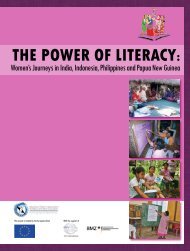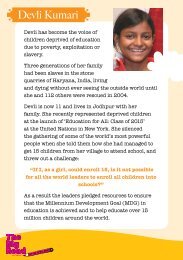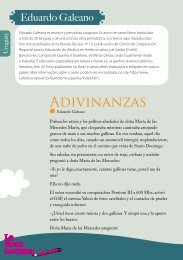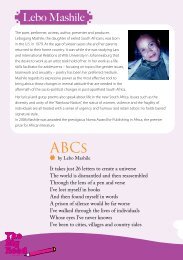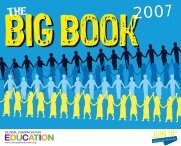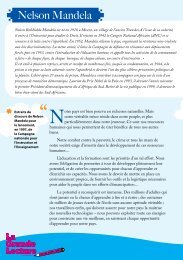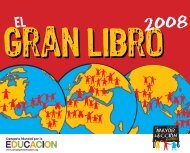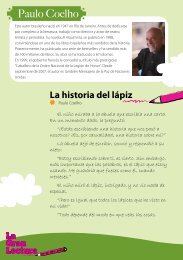Gender Discrimination in Education: The violation of rights of women ...
Gender Discrimination in Education: The violation of rights of women ...
Gender Discrimination in Education: The violation of rights of women ...
You also want an ePaper? Increase the reach of your titles
YUMPU automatically turns print PDFs into web optimized ePapers that Google loves.
CASE STUDY 3: PAKISTAN<br />
Legislative and policy context<br />
Pakistan is a signatory to various <strong>in</strong>ternational <strong>in</strong>struments on <strong>women</strong>’s <strong>rights</strong> <strong>in</strong>clud<strong>in</strong>g CEDAW, which it ratified <strong>in</strong> 1996.<br />
In response to the Beij<strong>in</strong>g Plan <strong>of</strong> Action as well as ratification <strong>of</strong> CEDAW, Pakistan has pursued <strong>in</strong>itiatives to implement<br />
gender equality and <strong>women</strong>’s empowerment. Further, the Constitution (1973) prohibits discrim<strong>in</strong>ation based on sex. In<br />
December 2011, Parliament unanimously passed two landmark laws aimed at protect<strong>in</strong>g <strong>women</strong> from negative customs.<br />
<strong>The</strong> new law seeks to punish <strong>of</strong>fences aga<strong>in</strong>st <strong>women</strong> such as forced marriages, depriv<strong>in</strong>g them from <strong>in</strong>heritance and marriage<br />
to the Quran. <strong>The</strong> second law crim<strong>in</strong>alizes throw<strong>in</strong>g acid at girls and <strong>women</strong> with life imprisonment as the maximum<br />
sentences for <strong>of</strong>fenders.<br />
<strong>The</strong> numbers<br />
Only four <strong>in</strong> 10 <strong>of</strong> Pakistani <strong>women</strong> over the age <strong>of</strong> 15 can read and write, compared to 70% <strong>of</strong> men. This dramatic educational<br />
disadvantage is the result <strong>of</strong> a deeply unequal education system. Although girls’ enrolment rates have improved,<br />
the net rate at primary level is still just 60%, compared to 72% for boys. At secondary level, the performance is even more<br />
appall<strong>in</strong>g (although the gender difference is smaller): the net enrolment rate for girls is just 29%. Altogether, more than 8<br />
million girls <strong>of</strong> school age (primary and secondary) are not <strong>in</strong> school. In addition, Pakistan has recently experienced one <strong>of</strong><br />
the worst monsoon floods <strong>in</strong> history. Around 680,000 girls were affected, and if they miss the start <strong>of</strong> the academic session,<br />
it will re<strong>in</strong>force the multiple barriers to education they already face.<br />
Violence<br />
Violence aga<strong>in</strong>st <strong>women</strong> <strong>in</strong> the form <strong>of</strong> physical, sexual and emotional abuse is widespread <strong>in</strong> Pakistan. Strict family, tribal<br />
and religious customs mean that some <strong>in</strong>timidat<strong>in</strong>g activities have become cultural norms, while domestic violence is<br />
seldom reported and rarely <strong>in</strong>vestigated. Violent acts committed ma<strong>in</strong>ly by men aga<strong>in</strong>st <strong>women</strong> with<strong>in</strong> the context <strong>of</strong> the<br />
subord<strong>in</strong>ate status <strong>of</strong> <strong>women</strong> which society seeks to preserve <strong>in</strong>clude domestic violence; sexual violence; traditional harmful<br />
practices <strong>in</strong>clud<strong>in</strong>g female genital mutilation, honor kill<strong>in</strong>g and dowry-related violence; and human traffick<strong>in</strong>g. Such<br />
widespread violence aga<strong>in</strong>st <strong>women</strong> can impact severely on girls’ and <strong>women</strong>’s education even when it does not take place<br />
at school: studies conducted <strong>in</strong> northern Pakistan, for <strong>in</strong>stance, have found that girls’ access to education was “severely”<br />
restricted because <strong>of</strong> their families’ fear <strong>of</strong> violence whilst travel<strong>in</strong>g. It should, moreover, be noted that female teachers, as<br />
well as students, can be the victims <strong>of</strong> violence: a report by USAID <strong>in</strong> north west Pakistan found that female teachers were<br />
frequently threatened or assaulted <strong>in</strong> the villages where they work and are frightened to leave the school. As well as the<br />
severe impact on these <strong>women</strong>, this will discourage other <strong>women</strong> from work<strong>in</strong>g as teachers, which <strong>in</strong> turn further damages<br />
girls’ educational prospects.<br />
Civil society action<br />
Pakistan’s National <strong>Education</strong> Coalition (PCE) has partnered with other civil society organizations to raise public outrage<br />
and demand governmental <strong>in</strong>tervention on violence aga<strong>in</strong>st <strong>women</strong> and girls. To this effect, the coalition has made various<br />
submissions and participated <strong>in</strong> preparatory work for the landmark laws crim<strong>in</strong>aliz<strong>in</strong>g violence aga<strong>in</strong>st <strong>women</strong>.<br />
Global Campaign for <strong>Education</strong><br />
16<br />
Pakistan Coalition for <strong>Education</strong>; UNESCO Institute <strong>of</strong> Statistics (http://www.uis.unesco.org); A Khan (1998) Female mobility<br />
and access to health and family plann<strong>in</strong>g services, Islamabad: M<strong>in</strong>istry for Population Welfare and London School <strong>of</strong> Hygiene<br />
and Tropical Medic<strong>in</strong>e.



